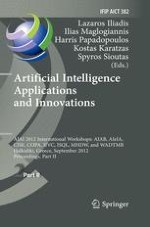This book constitutes the refereed proceedings of the Workshops held at the 8th IFIP WG 12.5 International Conference on Artificial Intelligence Applications and Innovations, AIAI 2012, in Halkidiki, Greece, in September 2012. The book includes a total of 66 interesting and innovative research papers from the following 8 workshops: the Second Artificial Intelligence Applications in Biomedicine Workshop (AIAB 2012), the First AI in Education Workshop: Innovations and Applications (AIeIA 2012), the Second International Workshop on Computational Intelligence in Software Engineering (CISE 2012), the First Conformal Prediction and Its Applications Workshop (COPA 2012), the First Intelligent Innovative Ways for Video-to-Video Communiccation in Modern Smart Cities Workshop (IIVC 2012), the Third Intelligent Systems for Quality of Life Information Services Workshop (ISQL 2012), the First Mining Humanistic Data Workshop (MHDW 2012), and the First Workshop on Algorithms for Data and Text Mining in Bioinformatics (WADTMB 2012).
